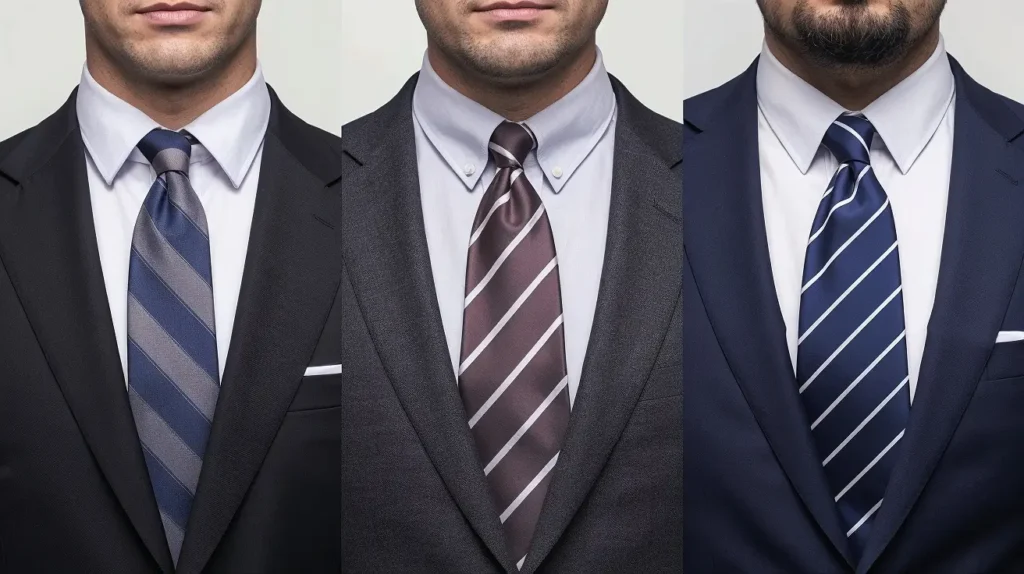Tie Width Guide: Choosing the Right Size for Your Body Type
Finding the right tie width isn’t just about following fashion trends—it’s about what looks best on you. Different body types call for different tie sizes, and choosing the right width can enhance your overall appearance. Whether you’re tall and slim, broad-shouldered, or somewhere in between, the width of your tie should complement your frame.
This guide will break down the basics of tie widths and help you match them to your body type so you can achieve a balanced and polished look. After all, a well-chosen tie doesn’t just complete an outfit; it can boost your confidence and make a lasting impression. Let’s get into the details of how to pick the perfect tie width for you.
Contents
Why Tie Width Matters
Think of your tie as the centerpiece of your outfit. Too wide, and you might look like you’ve time-traveled from the 70s. Too skinny, and you could end up looking like you raided a teenager’s closet. The right width balances your look and complements your body type. It’s a small detail, but it makes a big difference.
The Basics: Understanding Tie Widths
First things first – what are we talking about when we say “tie width”? It’s the measurement of the widest part of the tie, typically near the bottom.

Here’s a quick rundown:
- Skinny ties: 1.5 to 2.5 inches
- Slim ties: 2.25 to 2.75 inches
- Standard ties: 3 to 3.25 inches
- Wide ties: 3.25 to 3.5 inches
Tie widths have yo-yoed over the decades. The 1970s saw ties as wide as 4.5 inches, while the early 2000s brought back super skinny ties. Today, we’re in a sweet spot where various widths are acceptable, depending on your body type and personal style.
Finding Your Fit: Body Types and Tie Widths

Let’s break it down by body type:
1. Slim/Athletic Build
If you’re on the leaner side, congratulations – you can rock most tie widths. But to look your best, stick to slimmer ties. A width between 2.5 and 3 inches will complement your frame without overwhelming it.
Recommendation: The ZENXUS Skinny Tie is a great option for slim builds. It comes in various colors, perfect for mixing and matching with your wardrobe.
2. Average Build
For the guy with an average build, you’re in luck – standard tie widths are your friend. Go for ties between 2.75 and 3.25 inches. This range will balance your proportions nicely.
Recommendation: Check out the Classic Men’s Tie Set by KissTies. These ties hit the sweet spot for width and come in professional patterns suitable for work or special occasions.
3. Larger Build
If you’ve got a broader frame, wider ties are your go-to. Look for ties between 3.25 and 3.5 inches. They’ll create a balanced look and prevent the tie from appearing too small against your chest.
Recommendation: The Extra Long Tie by Adulove is perfect for larger builds. Not only does it have the right width, but the extra length ensures a proper fit for taller guys too.
Face Shapes and Tie Widths
Believe it or not, your face shape plays a role in choosing the right tie width. Here’s a quick guide:
- Round face: Go for a medium-width tie to create the illusion of length.
- Long face: Wider ties can help balance your proportions.
- Square face: Slim to medium-width ties work well, softening angular features.
- Oval face: You’re in luck – most tie widths will suit you well.
Other Factors to Consider
Lapel Width
Your tie should roughly match the width of your jacket’s lapel. A skinny tie with wide lapels looks off, as does a wide tie with narrow lapels.
Shirt Collar
The type of collar on your shirt can influence your tie choice:
- Spread collars: Work well with wider ties
- Point collars: Pair nicely with slimmer ties
- Button-down collars: Versatile, but generally look best with slim to medium-width ties
Measuring Your Ideal Tie Width
Want to get scientific about it? Here’s how to find your perfect tie width:
- Stand in front of a mirror in a well-fitted dress shirt.
- Measure the distance between the outer edges of your shirt collar points.
- Divide this measurement by 2.
- The result is your ideal tie width.
For example, if the distance between your collar points is 6 inches, your ideal tie width would be 3 inches.
Common Tie Width Mistakes to Avoid
- Going too extreme: Super skinny or extra-wide ties can look costume-like.
- Ignoring your jacket: Always consider your lapel width when choosing a tie.
- One-size-fits-all approach: What works for your buddy might not work for you.
- Forgetting the knot: A thick knot with a skinny tie looks odd, as does a tiny knot with a wide tie.
Wrapping It Up
Choosing the right tie-width isn’t rocket science, but it does require a bit of thought. Remember:
- Consider your body type and face shape
- Match your tie to your lapel width
- Think about the occasion and your shirt collar
- Don’t be afraid to measure for the perfect fit
Most importantly, wear your tie with confidence. The best accessory is always a genuine smile and a self-assured attitude.
Frequently Asked Questions
Q: Can I wear a skinny tie to a formal event?
A: While it’s not a hard no, skinny ties are generally considered less formal. For black-tie events or conservative settings, stick to standard width ties.
Q: Do clip-on ties come in different widths?
A: Yes, clip-on ties are available in various widths. However, for the best look and versatility, learning to tie a real tie is worth the effort.
Q: How do I know if my tie is too long or short?
A: The tip of your tie should just touch the top of your belt buckle. If it’s shorter or longer than this, it might be time for a new tie or to adjust your tying technique.
Q: Can I wear a bow tie instead of a regular tie?
A: Absolutely! Bow ties are a great alternative, especially for formal events or if you want to add a touch of personality to your outfit.
There you have it – your comprehensive guide to choosing the right tie width. Remember, these are guidelines, not strict rules. The most important thing is that you feel comfortable and confident in what you’re wearing. So go ahead, try on different widths, and find what works best for you. Your perfect tie is out there, and now you know exactly how to find it.